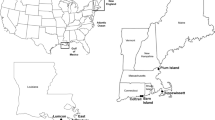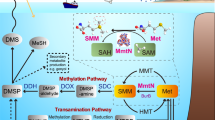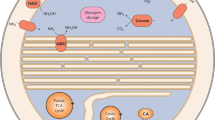Abstract
Quantitative PCR (qPCR) analysis revealed elevated relative abundance (1.8% of prokaryotes) of marine group 1 Crenarchaeota (MG1C) in two samples of southeastern US coastal bacterioplankton, collected in August 2008, compared with samples collected from the same site at different times (mean 0.026%). We analyzed the MG1C sequences in metatranscriptomes from these samples to gain an insight into the metabolism of MG1C population growing in the environment, and for comparison with ammonia-oxidizing bacteria (AOB) in the same samples. Assemblies revealed low diversity within sequences assigned to most individual MG1C open reading frames (ORFs) and high homology with ‘Candidatus Nitrosopumilus maritimus’ strain SCM1 genome sequences. Reads assigned to ORFs for ammonia uptake and oxidation accounted for 37% of all MG1C transcripts. We did not recover any reads for Nmar_1354–Nmar_1357, proposed to encode components of an alternative, nitroxyl-based ammonia oxidation pathway; however, reads from Nmar_1259 and Nmar_1667, annotated as encoding a multicopper oxidase with homology to nirK, were abundant. Reads assigned to two homologous ORFs (Nmar_1201 and Nmar_1547), annotated as hypothetical proteins were also abundant, suggesting that their unknown function is important to MG1C. Superoxide dismutase and peroxiredoxin-like transcripts were more abundant in the MG1C transcript pool than in the complete metatranscriptome, suggesting an enhanced response to oxidative stress by the MG1C population. qPCR indicated low AOB abundance (0.0010% of prokaryotes), and we found no transcripts related to ammonia oxidation and only one RuBisCO transcript among the transcripts assigned to AOB, suggesting they were not responding to the same environmental cues as the MG1C population.
Similar content being viewed by others
Log in or create a free account to read this content
Gain free access to this article, as well as selected content from this journal and more on nature.com
or
References
Agogue H, Brink M, Dinasquet J, Herndl GJ . (2008). Major gradients in putatively nitrifying and non-nitrifying Archaea in the deep North Atlantic. Nature 456: 788–791.
Altschul SF, Madden TL, Schaffer AA, Zhang J, Zhang Z, Miller W et al. (1997). Gapped BLAST and PSI-BLAST: a new generation of protein database search programs. Nucleic Acids Res 25: 3389–3402.
Bartossek R, Nicol GW, Lanzen A, Klenk H-P, Schleper C . (2010). Homologues of nitrite reductases in ammonia-oxidizing archaea: diversity and genomic context. Environ Microbiol 12: 1075–1088.
Beman JM, Francis CA . (2006). Diversity of ammonia-oxidizing Archaea and Bacteria in the sediments of a hypernutrified subtropical estuary: Bahia del Tobari, Mexico. Appl Environ Microbiol 72: 7767–7777.
Beman JM, Popp BN, Francis CA . (2008). Molecular and biogeochemical evidence for ammonia oxidation by marine Crenarchaeota in the Gulf of California. ISME J 2: 429–441.
Berg IA, Kockelkorn D, Buckel W, Fuchs G . (2007). A 3-hydroxypropionate/4-hydroxybutyrate autotrophic carbon dioxide assimilation pathway in Archaea. Science 318: 1782–1786.
Bernhard AE, Landry ZC, Blevins A, de la Torre JR, Giblin AE, Stahl DA . (2010). Abundance of ammonia-oxidizing Archaea and Bacteria along an estuarine salinity gradient in relation to potential nitrification rates. Appl Environ Microbiol 76: 1285–1289.
Biers EJ, Sun S, Howard EC . (2009). Prokaryotic genomes and diversity in the surface ocean: interrogating the Global Ocean Sampling metagenome. Appl Environ Microbiol 75: 2221–2229.
Caffrey JM, Bano N, Kalanetra K, Hollibaugh JT . (2007). Environmental factors controlling ammonia-oxidation by ammonia-oxidizing Bacteria and Archaea in Southeastern estuaries. ISME J 1: 660–662.
de Corte D, Yokokawa T, Varela MM, Agogue H, Herndl GJ . (2008). Spatial distribution of Bacteria and Archaea and amoA gene copy numbers throughout the water column of the Eastern Mediterranean Sea. ISME J 3: 147–158.
Francis CA, Beman JM, Kuypers MMM . (2007). New processes and players in the nitrogen cycle: the microbial ecology of anaerobic and archaeal ammonia oxidation. ISME J 1: 19–27.
Francis CA, Roberts KJ, Beman JM, Santoro AE, Oakley BB . (2005). Ubiquity and diversity of ammonia-oxidizing Archaea in water columns and sediments of the ocean. Proc Natl Acad Sci USA 102: 14683–14688.
Fuhrman J, Hagström Å . (2008). Bacterial and archaeal community structure and its patterns. In: Kirchman DL (ed). Microbial Ecology of the Oceans Second edn. John Wiley & Sons, Inc.: Hoboken, NJ, pp 45–90.
Gifford SM, Sharma S, Rinta-Kanto JM, Moran MA . (2010). Analysis of a marine microbial metatranscriptome as a function of sequencing depth. ISME J; doi:10.1038/ismej.2010.141.
Gomez-Alvarez V, Teal TK, Schmidt TM . (2009). Systematic artifacts in metagenomes from complex microbial communities. ISME J 3: 1–4.
Hallam SJ, Konstantinidis KT, Putnam N, Schleper C, Watanabe Y-i, Sugahara J et al. (2006a). Genomic analysis of the uncultivated marine crenarchaeote Cenarchaeum symbiosum. Proc Natl Acad Sci USA 103: 18296–18301.
Hallam SJ, Mincer TJ, Schleper C, Preston CM, Roberts K, Richardson PM et al. (2006b). Pathways of carbon assimilation and ammonia oxidation suggested by environmental genomic analyses of marine Crenarchaeota. PLoS Biol 4: e95.
Imlay JA . (2008). Cellular defenses against superoxide and hydrogen peroxide. Annu Rev Biochem 77: 755–776.
Kalanetra KM, Bano N, Hollibaugh JT . (2009). Ammonia-oxidizing Archaea in the Arctic Ocean and Antarctic coastal waters. Environ Microbiol 11: 2434–2445.
Karner MB, DeLong EF, Karl DM . (2001). Archaeal dominance in the mesopelagic zone of the Pacific Ocean. Nature 409: 507–510.
Kirchman DL, Elifantz HD, Ana I, Malmstrom RR, Cottrell MT . (2007). Standing stocks and activity of Archaea and Bacteria in the western Arctic Ocean. Limnol Oceanogr 52: 495–507.
Kockelkorn D, Fuchs G . (2009). Malonic semialdehyde reductase, succinic semialdehyde reductase, and succinyl-coenzyme A reductase from Metallosphaera sedula: enzymes of the autotrophic 3-hydroxypropionate/4-hydroxybutyrate cycle in sulfolobales. J Bacteriol 191: 6352–6362.
Konneke M, Bernhard AE, de la Torre JR, Walker CB, Waterbury JB, Stahl DA . (2005). Isolation of an autotrophic ammonia-oxidizing marine archaeon. Nature 437: 543–546.
Magalhaes CM, Machado A, Bordalo AA . (2009). Temporal variability in the abundance of ammonia- oxidizing bacteria vs archaea in sandy sediments of the Douro River estuary, Portugal. Aquat Microb Ecol 56: 13–23.
Martens-Habbena W, Berube PM, Urakawa H, de la Torre JR, Stahl DA . (2009). Ammonia oxidation kinetics determine niche separation of nitrifying Archaea and Bacteria. Nature 461: 976–979.
Mincer TJ, Church MJ, Taylor LT, Preston C, Karl DM, DeLong EF . (2007). Quantitative distribution of presumptive archaeal and bacterial nitrifiers in Monterey Bay and the North Pacific Subtropical Gyre. Environ Microbiol 9: 1162–1175.
Mosier AC, Francis CA . (2008). Relative abundance and diversity of ammonia-oxidizing archaea and bacteria in the San Francisco Bay estuary. Environ Microbiol 10: 3002–3016.
Norton J, Alzerreca J, Suwa Y, Klotz M . (2002). Diversity of ammonia monooxygenase operon in autotrophic ammonia-oxidizing bacteria. Arch Microbiol 177: 139–149.
Ouverney CC, Fuhrman JA . (2000). Marine planktonic archaea take up amino acids. Appl Environ Microbiol 66: 4829–4833.
Poretsky RS, Bano N, Buchan A, Hollibaugh JT, Moran MA . (2006). Environmental transcriptomics: a method to access expressed genes in complex microbial communities. Molecular Microbial Ecology Manual, 3rd Edition, Section 8, pp 1892–1904.
Poretsky RS, Gifford S, Rinta-Kanto J, Vila-Costa M, Moran MA . (2009). Analyzing gene expression from marine microbial communities using environmental transcriptomics. J Vis Exp; doi: 10.3791/10860.
Poretsky RS, Sun S, Mou X, Moran MA . (2010). Transporter genes expressed by coastal bacterioplankton in response to dissolved organic carbon. Environ Microbiol 12: 616–627.
Prosser JI, Nicol GW . (2008). Relative contributions of archaea and bacteria to aerobic ammonia oxidation in the environment. Environ Microbiol 10: 2931–2941.
Santoro AE, Casciotti KL, Francis CA . (2010). Activity, abundance and diversity of nitrifying archaea and bacteria in the central California Current. Environ Microbiol 12: 1989–2006.
Santoro AE, Francis CA, de Sieyes NR, Boehm AB . (2008). Shifts in the relative abundance of ammonia-oxidizing bacteria and archaea across physicochemical gradients in a subterranean estuary. Environ Microbiol 10: 1068–1079.
Shi Y, Tyson GW, DeLong EF . (2009). Metatranscriptomics reveals unique microbial small RNAs in the ocean's water column. Nature 459: 266–269.
Teira E, Reinthaler T, Pernthaler A, Pernthaler J, Herndl GJ . (2004). Combining catalyzed reporter deposition-fluorescence in situ hybridization and microautoradiography to detect substrate utilization by Bacteria and Archaea in the deep ocean. Appl Environ Microbiol 70: 4411–4414.
Treusch AH, Leininger S, Kletzin A, Schuster SC, Klenk H-P, Schleper C . (2005). Novel genes for nitrite reductase and Amo-related proteins indicate a role of uncultivated mesophilic crenarchaeota in nitrogen cycling. Environ Microbiol 7: 1985–1995.
Urakawa H, Martens-Habbena W, Stahl DA . (2010). High abundance of ammonia-oxidizing Archaea in coastal waters, determined using a modified DNA extraction method. Appl Environ Microbiol 76: 2129–2135.
Venter JC, Remington K, Heidelberg JF, Halpern AL, Rusch D, Eisen JA et al. (2004). Environmental genome shotgun sequencing of the Sargasso Sea. Science 304: 66–74.
Verity PG . (2002). A decade of change in the Skidaway River estuary. I. Hydrography and nutrients. Estuaries 25: 944–960.
Walker CB, de la Torre JR, Klotz MG, Urakawa H, Pinel N, Arp DJ et al. (2010). Nitrosopumilus maritimus genome reveals unique mechanisms for nitrification and autotrophy in globally distributed marine crenarchaea. Proc Natl Acad Sci USA 107: 8818–8823.
Wuchter C, Abbas B, Coolen MJL, Herfort L, van Bleijswijk J, Timmers P et al. (2006). Archaeal nitrification in the ocean. Proc Natl Acad Sci USA 103: 12317–12322.
Zaikova E, Walsh DA, Stilwell CP, Mohn WW, Tortell PD, Hallam SJ . (2010). Microbial community dynamics in a seasonally anoxic fjord: Saanich Inlet, British Columbia. Environ Microbiol 12: 172–191.
Zhang Z, Schwartz S, Wagner L, Miller W . (2000). A greedy algorithm for aligning DNA sequences. J Comput Biol 7: 203–214.
Acknowledgements
We thank R Newton for assistance with sample collection. L Tomsho and S Schuster provided 454 sequencing expertise. S Obrebski assisted with statistical analyses. The manuscript was greatly improved by the helpful comments of reviewers of earlier versions. We thank them for their efforts. This project was funded by grants from the Gordon and Betty Moore Foundation and the National Science Foundation (MCB0702125, OCE0620959 and OCE0352216).
Author information
Authors and Affiliations
Corresponding authors
Additional information
Supplementary Information accompanies the paper on The ISME Journal website
Supplementary information
Rights and permissions
About this article
Cite this article
Hollibaugh, J., Gifford, S., Sharma, S. et al. Metatranscriptomic analysis of ammonia-oxidizing organisms in an estuarine bacterioplankton assemblage. ISME J 5, 866–878 (2011). https://doi.org/10.1038/ismej.2010.172
Received:
Revised:
Accepted:
Published:
Issue date:
DOI: https://doi.org/10.1038/ismej.2010.172
Keywords
This article is cited by
-
Influence of organic ammonium derivatives on the equilibria between NH4+, NO2− and NO3− ions in the Nistru River water
Scientific Reports (2022)
-
The contribution of nirK gene-containing thaumarchaea to denitrification and N2O production across coastal sediment and terrestrial ecosystems
Journal of Soils and Sediments (2022)
-
High diversity of planktonic prokaryotes in Arctic Kongsfjorden seawaters in summer 2015
Polar Biology (2021)
-
Changing Biogeochemistry and Invertebrate Community Composition at Newly Deployed Artificial Reefs in the Northeast Gulf of Mexico
Estuaries and Coasts (2020)
-
Alternative strategies of nutrient acquisition and energy conservation map to the biogeography of marine ammonia-oxidizing archaea
The ISME Journal (2020)



